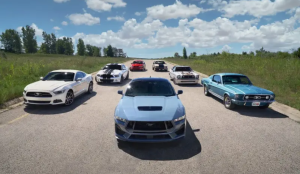The second generation of the Ford Mustang arrived in 1974 and introduced a new chapter in the car’s history. Known as the Mustang II, this generation was very different from the first. It was smaller, lighter, and designed to meet the changing needs of the 1970s, including rising fuel prices and new emissions regulations.
Design and Platform
Ford built the Mustang II on the Ford Pinto platform. It focused more on fuel economy and comfort rather than raw power and speed. Some Mustang fans were disappointed at the time, but today, the Mustang II is appreciated for its unique place in the model’s history.
A Car for Its Time
The Mustang II was released just in time for the 1973 oil crisis. Gas prices were rising quickly, and people needed more fuel-efficient cars. The Mustang II had a smaller engine, which helped it become more affordable to drive and maintain.
Engine Options
From 1974 to 1978, the design of the Mustang II stayed mostly the same, but Ford made some important changes each year. The early models had a 2.3-liter four-cylinder engine or a 2.8-liter V6. Later on, Ford brought back a V8 option – the 5.0-liter engine in 1975 – after many customers asked for more power.
Body Styles and Special Editions
The car was available in coupe and hatchback body styles. One popular version was the Mustang II Cobra II, which had racing stripes and a sporty appearance. Another special edition was the King Cobra, introduced in 1978. It was the most powerful version of the Mustang II and had a more aggressive design.
Legacy and Popularity
While the Mustang II didn’t offer the same high-speed thrills as the first generation, it was a smart move for the time. It kept the Mustang name alive during a tough period in the auto industry.
Collectors and Restoration
Today, the Mustang II is gaining interest among collectors and enthusiasts. It represents a unique time when American cars were adjusting to new rules and customer demands. Many people now restore Mustang IIs and enjoy their retro style.
Importance of Workshop Manuals
If you’re restoring a second-generation Mustang, having a workshop manual is very helpful. It can guide you through repairs, maintenance, and original specifications. These manuals can save time and make sure your restoration project goes smoothly.
Conclusion
In summary, the 2nd generation Ford Mustang may not have had the same power as the original, but it played an important role in the car’s history. It helped the Mustang survive and evolve during a difficult decade and paved the way for future models.





